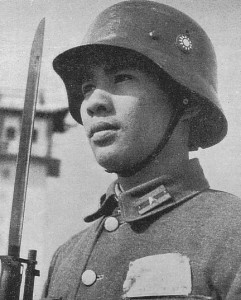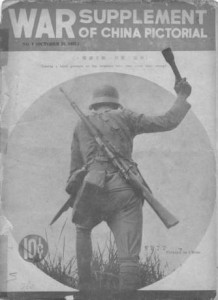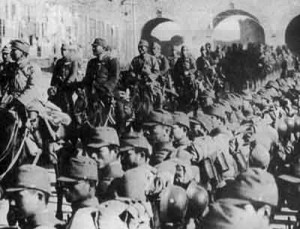The Chinese ‘Fritz’
- By Peter Harmsen
- 8 October, 2013
- 3 Comments
 One of the most conspicuous features of the elite units of the Chinese army that went to war with Japan in 1937 was their widespread use of German equipment, and, most conspicuous of all, of the trademark German helmet. In the early and mid-30s, Germany was the main provider of military assistance to Chiang Kai-shek’s Nationalist forces. This meant the dispatch of a fair number of German officers who acted as advisors and teachers for China as it raced to build a modern military force. It also meant large shipments of military supplies, including 300,000 M35 helmets.
One of the most conspicuous features of the elite units of the Chinese army that went to war with Japan in 1937 was their widespread use of German equipment, and, most conspicuous of all, of the trademark German helmet. In the early and mid-30s, Germany was the main provider of military assistance to Chiang Kai-shek’s Nationalist forces. This meant the dispatch of a fair number of German officers who acted as advisors and teachers for China as it raced to build a modern military force. It also meant large shipments of military supplies, including 300,000 M35 helmets.
The German helmet, or Stahlhelm, had been developed during the Great War. Its design, offering protection of a large area of the head and neck, was considered superior to the design of rival militaries, especially the flat Brodie helmet used by British and American troops. In China, it was so popular that even some soldiers in the Japanese army started using helmets taken from dead or surrendering Chinese troops. They can be seen carrying in slung across their backs as they march into Nanjing in December 1937.
After the first violent phase of the Sino-Japanese War was over, the helmet continued to be in use, on both sides. Even Chinese puppet soldiers defending the pro-Japanese regime in East China were frequently equipped with the M35. Once the United States had entered the war against Japan in late 1941, the German helmet gradually grew out of use among Chiang Kai-shek’s forces, as the American M1 helmet was supplied in great numbers. However, the German model never disappeared completely, and saw use both in the 1945-1949 Chinese Civil War and on the communist side during 1950-1953 Korean War.
Elsewhere in the world German-style helmets have never been completely abandoned, despite their association, in popular culture as well as in real life, with Nazi atrocities. A version, only slightly modified, has been used in Latin American armies all through the post-war years, and even East Germany, for all its talk of making a clean break with the past, adopted a helmet that was really just a flatter version of the old Stahlhelm. Finally, the US military acknowledged the superior protective qualities of the design and introduced the so-called Personnel Armor System for Ground Troops Helmet in the early 1980s. No one was fooled by the long bureaucratic designation, and it immediately got the nickname “Fritz.”

Japan’s army enters Nanjing in late 1937. Two soldiers in the foreground are carrying German helmets slung across their backs
The German light machinegun MG42 has had a similar long life in the post-war period, probably even more so because it was less easily identifiable with the Nazi reign of terror over Europe. But the lesson is clear: The quality of design and technology has nothing to do with the ethical standards of the people that make it.



 Copyright © 2025
Copyright © 2025
Yes, the Chinese fighting for Japan was using the captured M35 helmets of Chiang Kai Shiek and so was the Japanese M90 helmets were used on the Chinese side of the Sino-Japanese conflict although it would be very difficult to tell which sides the soldiers were on when both sides were wearing the same Japanese M90 helmets !
a very comprhensive blog to understand my knowledge on Chinese M35
history. Thanks a lot, Renato
My dad was in the Chinese Army in 1937 fighting off the Japanese. He wore a German helmet, German uniform, and had a German machine gun that killed 100 Japanese per minute.